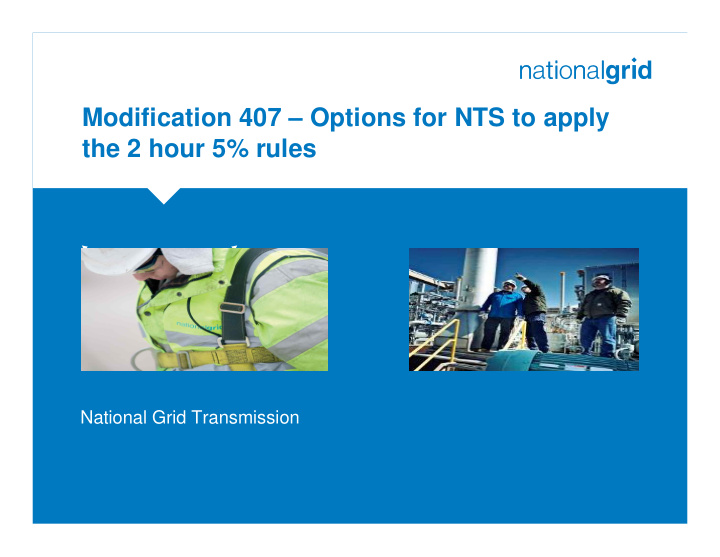



Modification 407 – Options for NTS to apply the 2 hour 5% rules Place your chosen image here. The four corners must just cover the arrow tips. For covers, the three pictures should be the same size and in a straight line. National Grid Transmission
Mod 407 Workgroup (26 Jan) � W&W indicated that they are considering amending Mod 407 to introduce flexibility to apply the current 2 hour 5% rule to allow Consumer’s needs to be met majority of the time � Initial NTS strawman options presented � Difficult days/GBAs – Margins Notice and/or Gas Deficit Warning � High/low demand days – national or local (as agreed in advance by industry participants) � Manage OAD 2 hour 5% rule the same as UNC TPD J4.5.6 and 4.5.7 � Section J rules allow NTS to accept a changed rate of offtake with a reduced notice period, as long as it does not give rise to an Operational Balancing Requirement 2
GDN feedback � Option 3 supported by UKD in Mod 407 workgroup – “appeared to be the best short-term solution along side some advanced notification” � W&W and NTS liaison meeting (Jan 31 st ) – brief discussion on Mod 407/option 3 � An advance day ahead notice would help them to manage communication to their customers � Saw merit in a simple day ahead on/off rule but accepted that such a day ahead notice may increase the likelihood of the rule being on � Would also like to see that NTS could turn the rule off (within day) if it was appropriate to do so � Asked for an NTS view on how often the rule would be applied under any proposed methodology/options 3
Management of the rule by NTS � System Flexibility Restriction Notice are issued in accordance with the Short Term Access to System Flexibility Allocation Methodology produced in accordance with UNC TPD Section J7.3.2 by National Grid NTS. https://www.nationalgrid.com/uk/Gas/OperationalInfo/NTSExitZones/ � Methodology outlines principles by which NTS will make short term access to system flexibility available to Users, over and above the Users prevailing entitlements � The current version of the methodology came into force on the 1st of October 2012 to reflect changes made to support Exit Reform. � Two System Flexibility Restriction Notices have been issued since and only a small number were issued under the 6 years of the previous methodology (pre Exit Reform). 4
NTS review of methodology � Mod 407 System Flexibility Transmission Work Group has been reviewing the methodology to assess how the LDZ 2 hour 5% rule could be included and the use of additional advance notices � Option 1 - Methodology amended to include LDZ 2hr.5% rule � Option 2 - Option 1 and day ahead advance notice [D-1 18:00 to 22:00] A. Day ahead notice to turn the 2 hour 5% rule on - NTS has identified that OPNs for LDZ offtakes requesting short term flexibility will not be accommodated B. Advance warning notice from NTS that LDZ offtakes short term flex requests may not be accommodated [rule not on at that stage] 5
System Flexibility Allocation Methodology - ASIS 6
Option 1 - Methodology amended to include LDZ rule 7
Option 1 Pros and cons Advantages Disadvantages • Minimal changes required to the • Provides no specific methodology to accommodate LDZ rule advance warning notice • Consistent with approach to requests from day ahead to individual offtakes (including Direct GDNs/consumers with Connected Power Stations), for changes regards to whether the 2 in the rate of offtake for a lesser period of hour 5% rule is to/may be notice (1, 2, 4 hour rule) applied within the gas day • Where an OPN is rejected or NTS foresee • GDN compliance may be short term system flex issues, Notices are difficult as a result issued to all Users providing advance [1/2 hour to 1 hour] notice that an OPN requesting system flexibility may be rejected • The number of SFRNs issued and OPNs rejected historically has been low [2-4 per annum] 8
Option 2 - Day ahead advance notice 9
Option 2a (Rule on notice) - Pros and cons Advantages Disadvantages • Provides specific advance • GNCC procedures and enhanced warning notice day ahead to network assessment capability GDNs/consumers with regards to required whether the 2 hour 5% rule is on • In some cases [system constraints] • GDN compliance with rule NTS may need to request a GDN to expected to improve increase the rate of offtake, when • May drive improvements in OPN the rule prevents this and demand forecasting • The number of days the rule could accuracy be on is estimated at between 2% and 5% of days • depends on quality of OPNs/demand forecasts 10
Option 2b (advance warning notice) - Pros and cons Advantages Disadvantages • Complements current methology • GNCC procedures and enhanced • Provides specific advance warning network assessment capability notice day ahead to required GDNs/consumers with regards to • The number of days the advance whether the 2 hour 5% rule may be notice could be issued is applied estimated at between 2% and 5% • The notice does not conflict with of days requests to GDNs to increase a rate • depends on quality of of offtake [system constraints] OPNs/demand forecasts • GDN compliance with rule expected to improve • May drive improvements in OPN and demand forecasting accuracy • OPNs would not be rejected unnecessarily as the current methodology would still apply 11
Recommend
More recommend